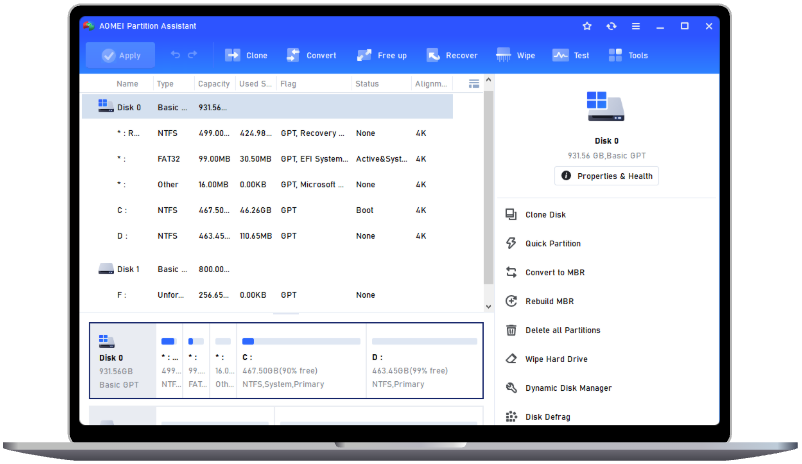How to Check What Your Password Is for Computer
This guide explores four effective methods to figure out how to check what your password is for computer. Follow the step-by-step instructions and useful tips to check the password securely.
Is there any way to find my current user password?
“I forgot my computer password, however, I do have it unlocked. It doesn't require me to put in a password because the screen just goes to idle mode and if I click on it, it will turn on. I am scared that I might accidentally turn it off by habit or it might restart causing me to lose a lot. I want to find a way to get my current password.”
Forgetting passwords is a common frustration that often locks users out of their computers. However, the Windows operating system keeps login credentials stored in various locations. With the right approach, users can know how to check what your password is for computer.
How to check what your password is for computer
This section offers a detailed guide on how to check what your password is for computer Windows 11 through four effective methods.
Method 1. Check password using Credential Manager
Credential Manager securely stores saved passwords for both system and web accounts on a Windows PC. While it doesn’t display complete passwords, it allows users to manage stored credentials effectively. Follow these steps to locate and modify Windows login information:
Step 1. Type "Control Panel" into the search bar at the bottom of the screen and select the corresponding result.
Step 2. Once the Control Panel window appears, navigate to "User Accounts" to view administrator details.
Step 3. Click "Credential Manager" to access stored login information. Choose "Windows Credentials" to manage system credentials.
Step 4. Locate the required credential under "Windows Credentials". Click the dropdown icon to expand details, then select "Remove" to delete it.
Step 5. Since Credential Manager does not reveal saved passwords, an alternative approach is to create a new one. Click "Add a Windows credential" enter the necessary details, and save the new login credentials.
Method 2. Know computer password via CMD
If you need to retrieve your administrator password in Windows 10, Command Prompt offers an alternative method. This is particularly useful if you cannot access Credential Manager due to a forgotten administrator password. Follow these steps to locate stored usernames and passwords using the command line:
Step 1. Click on the Search bar in the taskbar, type "CMD" and locate the Command Prompt option. Right-click it and select "Run as administrator".
Step 2. Once the Command Prompt window appears, type the following command and press Enter:
rundll32.exe keymgr.dll,KRShowKeyMgr
Step 3. After executing the command, a new window will appear displaying saved usernames and passwords under "Stored User Names and Passwords". If necessary, you can back up and restore these credentials on another system.
Method 3. Check PC password in the Registry Editor
The Registry Editor provides another way to locate stored credentials in Windows 10. However, since modifying the Windows Registry can impact system functionality, proceed with caution. Follow these steps to access stored usernames and passwords:
Step 1. Press "Windows + S" to open the search bar. Type "regedit" and select Registry Editor to launch it.
Step 2. In the Registry Editor window, follow this path to access login credentials:
Computer\HKEY_LOCAL_MACHINE\SOFTWARE\Microsoft\Windows NT\CurrentVersion\Winlogon
Step 3. Scroll through the list of registry entries and look for "DefaultPassword". Double-click it to reveal any stored password information.
Method 4. Reset the password to know it
If you are unable to locate your computer password using the previous methods, resetting it may be the best solution. By resetting the password, you can regain access to your system and set a new one that is easier to remember. In such a situation, third-party password recovery tools offer a reliable alternative. AOMEI Partition Assistant is a powerful solution designed specifically for resetting Windows passwords, making it an excellent choice for unlocking a locked PC.
This versatile tool supports a wide range of Windows operating systems, including Windows 11, 10, 8, and 7, regardless of the computer brand—whether HP, Dell, Lenovo, or others. It ensures a seamless password reset process without risking data loss, eliminating concerns about system compatibility.
Unlike conventional recovery methods, this advanced tool allows you to create a password reset USB on any working Windows PC. Once prepared, the USB can be used to reset passwords on another Windows computer, providing a fast and efficient solution.
Step 1. Begin by installing and launching AOMEI Partition Assistant. Once on the main interface, navigate to the "Tools" section and choose "Reset Windows Password".
Step 2. Proceed by clicking "Next" to initiate the creation of a bootable USB using WinPE.
Step 3. Select the prepared USB device and click "Proceed" to proceed to the next step.
Step 4. Take a moment to review the provided information and confirm your decision by clicking "Yes".
Step 5. Adjust the boot drive drive to allow the PC to boot from it.
Step 6. Once AOMEI Partition Assistant is visible, select "Reset Password", then read the information displayed and continue by clicking "Next".
Step 7. Choose the desired username and select the appropriate features based on your specific requirements. To reset the password, simply click on "Reset Account Password" and click “Next”.
Step 8. In the new window, input the new password and click “Yes”.
Conclusion
This guide has explored multiple methods to retrieve usernames and passwords on a Windows 10 computer. From built-in tools like Credential Manager, Command Prompt, and Registry Editor to advanced third-party solutions like AOMEI Partition Assistant, various approaches are available.
If you need to reset a password on a Windows Server, consider using the Server Edition of AOMEI Partition Assistant.


